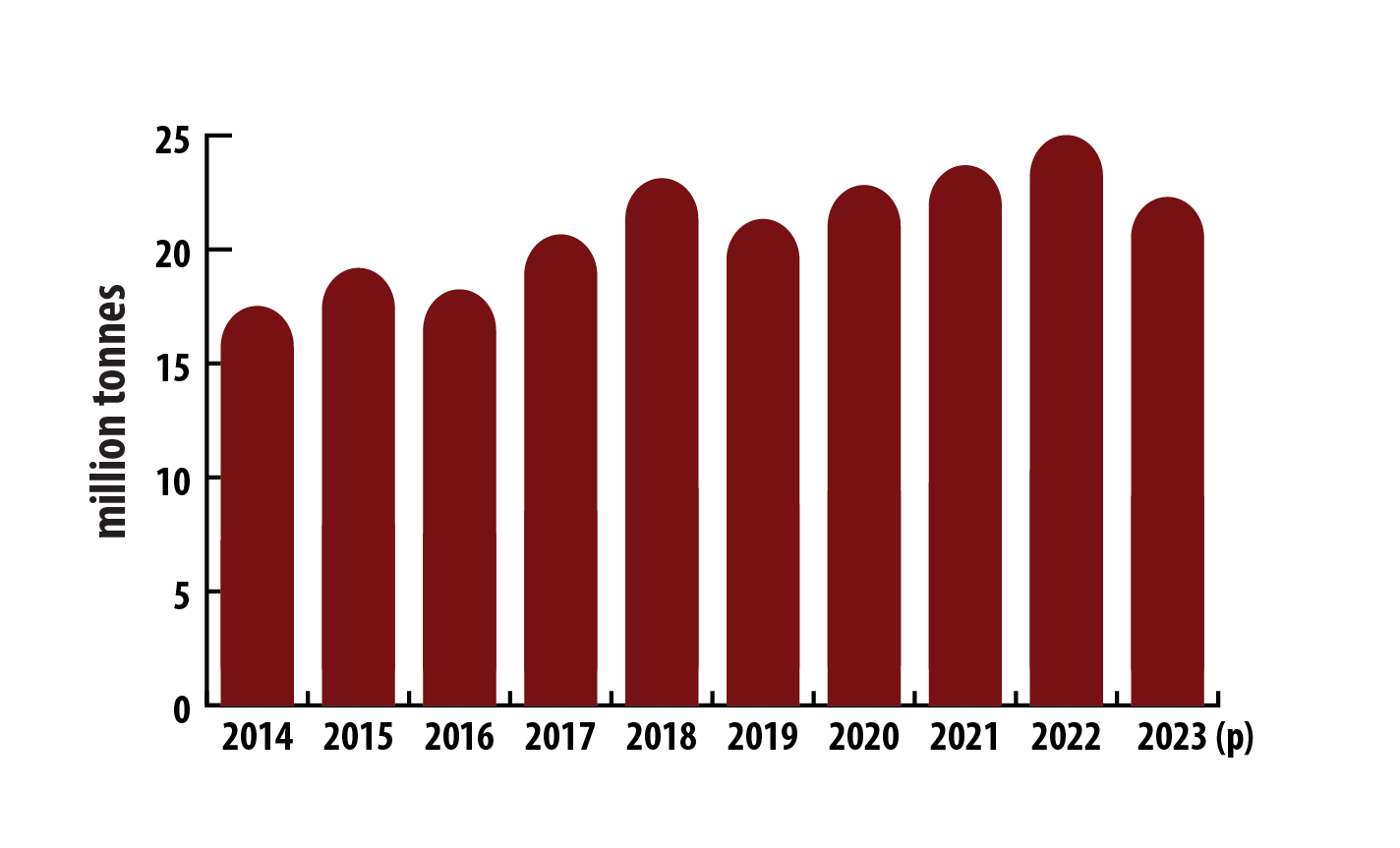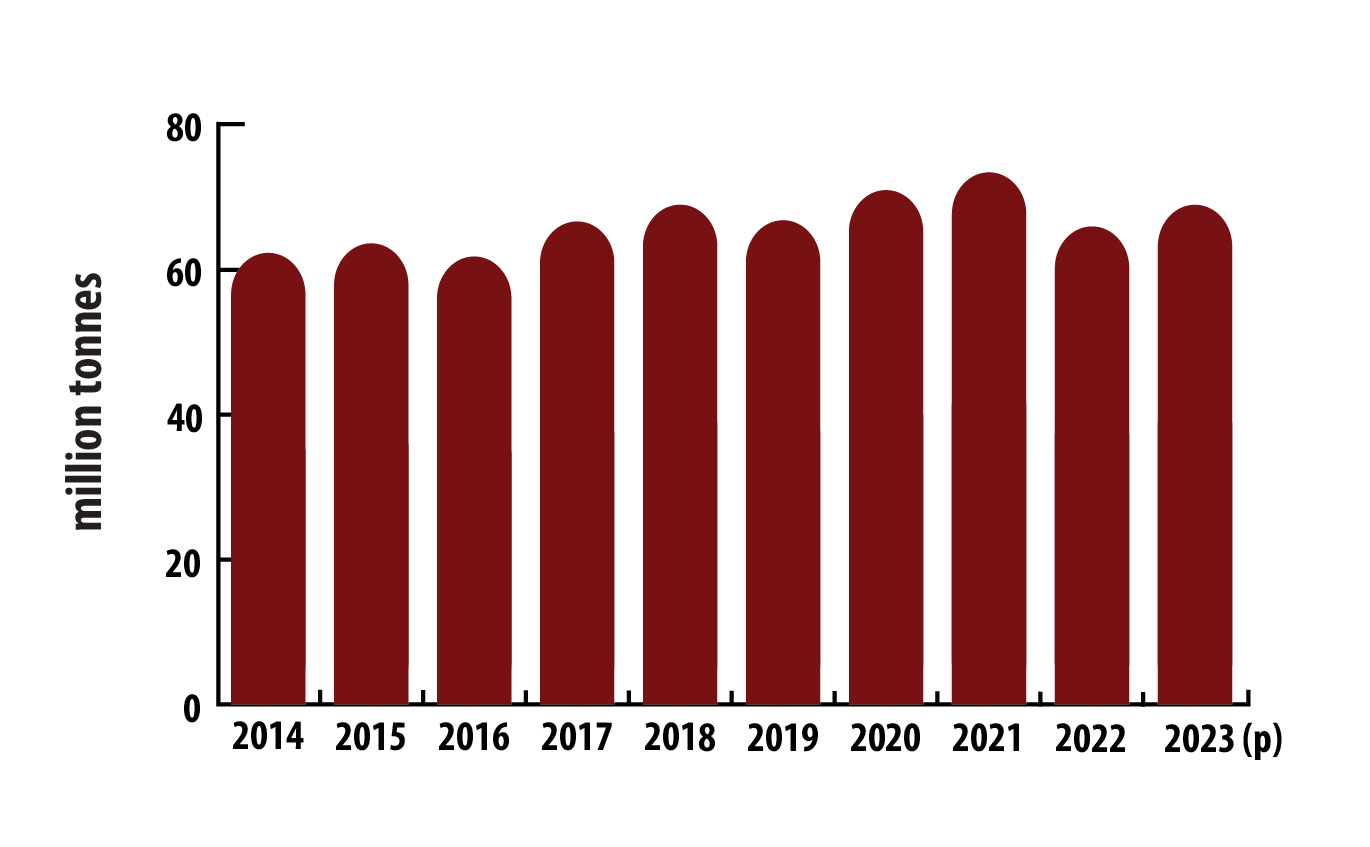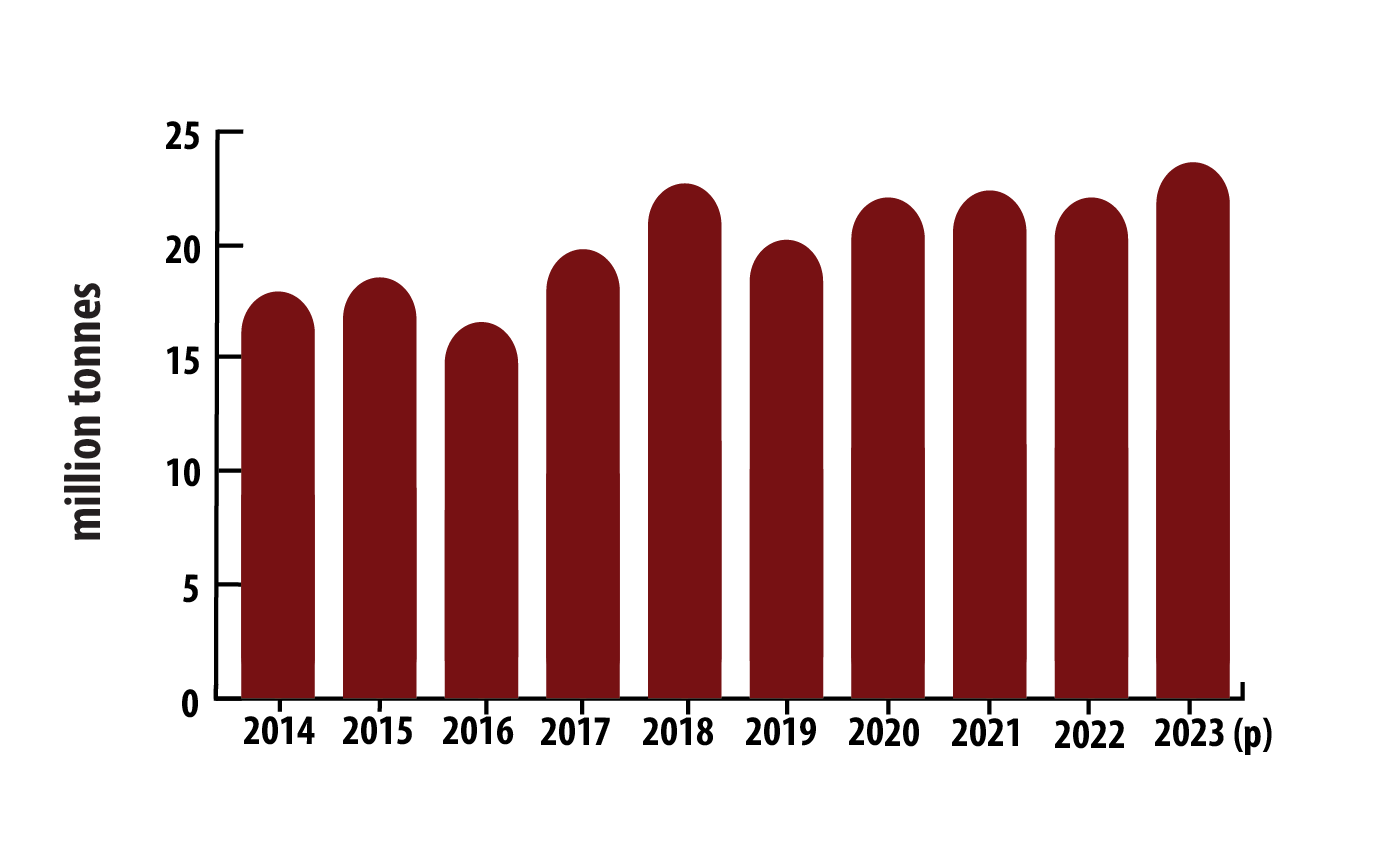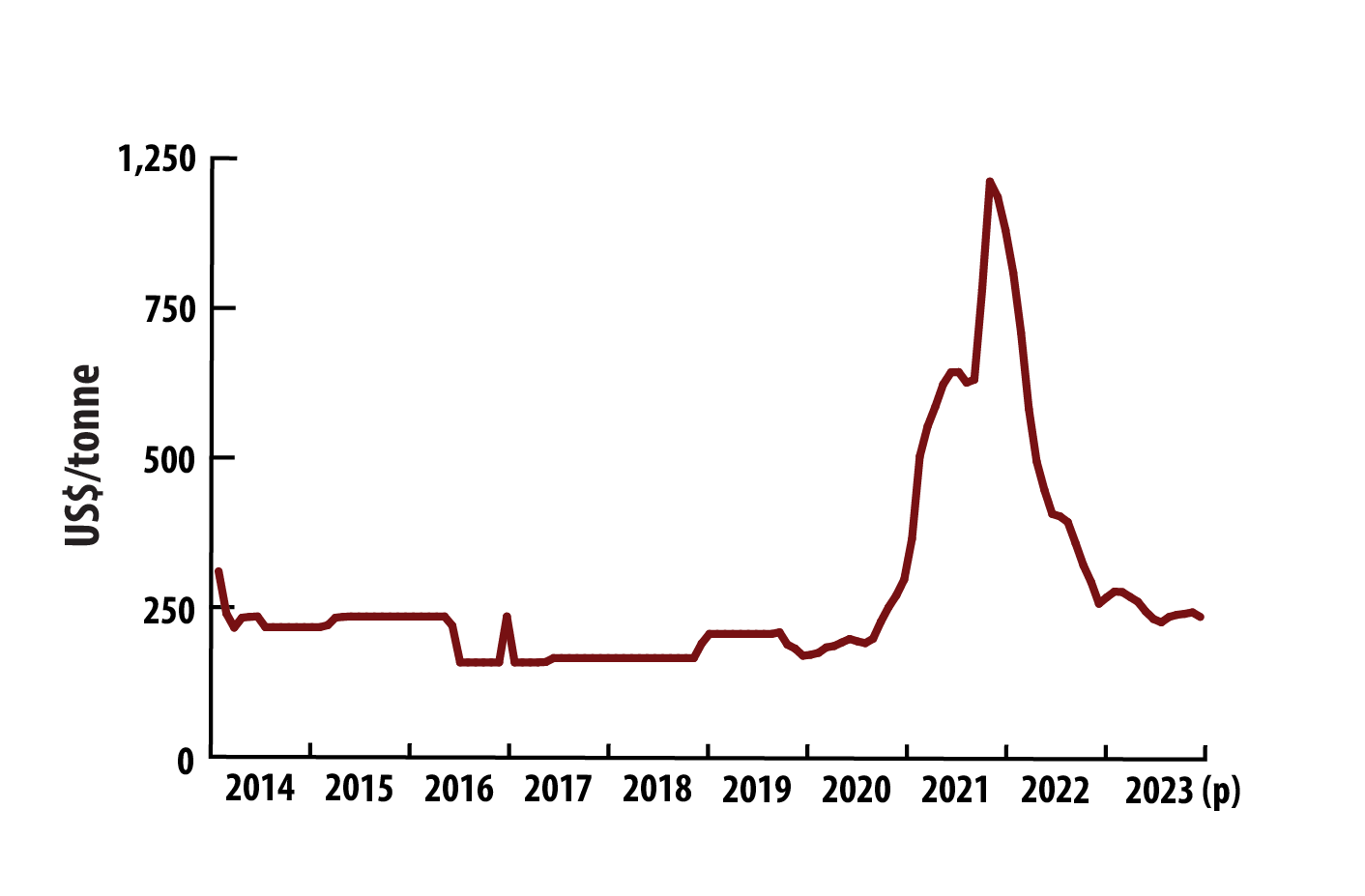
Potash refers to a group of minerals and chemicals that contain potassium (chemical symbol K), a vital nutrient for plants and a key component in fertilizers.
It is produced primarily as potassium chloride (KCl), also known as muriate of potash (MOP). Because of variations in potassium content among deposits, potash is often measured and reported in terms of potassium oxide (K2O) equivalence for consistency.
Key facts
- Potash is primarily used to produce fertilizer.
- Canada is the world’s largest producer and exporter of potash.
- Canada has the world’s largest potash reserves, with 1.1 billion tonnes of potash (potassium oxide equivalent).
Learn more about potash
 Uses
Uses
Potash is used primarily in fertilizers (approximately 95%) to support plant growth, increase crop yield and disease resistance, and enhance water preservation. Small quantities are used in manufacturing potassium-bearing chemicals such as:
- detergents
- ceramics
- pharmaceuticals
- water conditioners
- alternatives to de-icing salt
Potassium is an essential element of the human diet, required for the growth and maintenance of tissues, muscles, and organs and for the electrical activity of the heart. There is no substitute for potassium as a vital nutrient for plants, animals and humans.
 Production
Production
Potash in Canada is mined from underground deposits, either by conventional underground ore mining or by injecting water into the underground ore body and extracting the resulting brine (solution mining).
Canada’s 11 active mines are in Saskatchewan, and in 2023, they produced an estimated 21.9 million tonnes of potash (MOP), a decrease of approximately 2.7 million tonnes from the previous year.
Four companies account for all potash production in Canada: Nutrien Ltd., The Mosaic Company, Compass Minerals, and German fertilizer producer K+S Potash Canada.
BHP is advancing stages 1 and 2 of the Jansen potash project in Saskatchewan. The first stage is expected to start production in late 2026 and is projected to yield about 4.2 million tonnes of potash annually. The second stage is anticipated to start production in 2029 and double the capacity of the mine to reach 8.5 million tonnes a year when fully operational.
Consult a map of producing Canadian mines
Canadian production of potash (potassium chloride), 2014–2023 (p)

Text version
This bar chart illustrates Canada’s annual potash mine production from 2014 to 2023. Production started at 15.1 million tonnes in 2014 and rose steadily to 18.8 million tonnes by 2015. It then surpassed 20 million tonnes by 2018 and continued to climb, reaching a peak of 24.5 million tonnes in 2022. Preliminary data for 2023 indicate a 10.8% year-over-year decline, with production at 21.9 million tonnes.
 International context
International context
Find out more about potash production on an international scale.
| Ranking | Country | Tonnes (thousands) | Percentage of total |
|---|---|---|---|
| 1 | Canada | 21,875 | 32.4% |
| 2 | Russia | 12,547 | 18.6% |
| 3 | Belarus | 10,093 | 14.9% |
| 4 | China | 6,267 | 9.3% |
| 5 | Israel | 3,626 | 5.4% |
| - | Other countries | 13,134 | 19.4% |
| Total | 67,543 | 100.0% |
Global potash production was estimated at 67.5 million tonnes in 2023. Canada remained the world’s largest producer, contributing 32.4% of the global supply.
Canada, Russia and Belarus typically dominate global potash production, together accounting for 65.9% in 2023, similar to the previous year. However, Canada’s share decreased by 5.6 percentage points from 38.0% in 2022 because of domestic supply chain disruptions including transportation strikes and a record-setting forest fire season. Meanwhile, Belarusian potash production has stabilized following adjustments to geopolitical and sanctions-related impacts, and Russia’s market share has remained relatively steady.
World production of potash (potassium chloride), 2014–2023 (p)

Text version
This bar chart illustrates global potash production from 2014 to 2023. Production began at approximately 61.0 million tons in 2014, rising steadily to 71.9 million tonnes by 2021, before falling to 64.6 million tonnes in 2022. In 2023, production rebounded to 67.5 million tonnes.
In 2023, global potash reserves were estimated at more than 3.6 billion tonnes (potassium oxide equivalent). Canada holds the largest share, with known reserves of 1.1 billion tonnes. The following table lists countries with the largest potash reserves globally.
| Ranking | Country | Recoverable ore (million tonnes) |
Potassium oxide equivalent (million tonnes) |
|---|---|---|---|
| 1 | Canada | 4,500 | 1,100 |
| 2 | Belarus | 3,300 | 750 |
| 3 | Russia | N/A | 650 |
| 4 | United States | 970 | 220 |
| 5 | China | N/A | 180 |
| 6 | Germany | N/A | 150 |
| - | Other countries | 1,150 | 300 |
| Total | >11,280 | >3,595 |
 Trade
Trade
Canada leads the world in potash exports, shipping about 22.8 million tonnes in 2023, which accounts for over 41% of global exports. The leading destinations of Canadian exports of potash were the United States (46%), Brazil (19%) and China (8%).
Canadian exports of potash (potassium chloride), 2014–2023 (p)

Text version
This bar chart illustrates Canadian potash exports from 2014 to 2023. Exports started at 17.3 million tonnes in 2014 and increased to 17.9 million tonnes in 2015. After declining to16.0 million tonnes in 2016, exports rose to a decade high of 21.9 million tonnes in 2018. After a slight decrease to 19.5 million tonnes in 2019, exports stabilized around 21.5 million tonnes in subsequent years before increasing to nearly 22.8 million tonnes in 2023.
In 2023, Canada, Belarus and Russia accounted for almost 76% of global potash exports.
| Ranking | Country | Tonnes (thousands) | Percentage of total |
|---|---|---|---|
| 1 | Canada | 22,794 | 41.2% |
| 2 | Russia | 9,962 | 18.0% |
| 3 | Belarus | 9,198 | 16.6% |
| 4 | Israel | 3,737 | 6.8% |
| 5 | Germany | 3,190 | 5.8% |
| - | Other countries | 6,428 | 11.6% |
| Total | 55,309 | 100% |
World exports of potash (potassium chloride), 2014–2023 (p)

Text version
This bar chart illustrates global potash exports from 2014 to 2023. Exports were approximately 48.8 million tonnes in 2014, declined to 45.4 million tonnes by 2016, and then rebounded, peaking at nearly 56.7 million tonnes in 2021. In 2022, exports fell sharply by more than 10 million tonnes because of geopolitical events and the Russian invasion of Ukraine. However, by 2023, global potash exports had nearly recovered to 55.3 million tonnes.
 Prices
Prices
Potash prices declined from 2013 to 2016 and remained relatively low until 2020. In 2021, prices rose sharply to US$807 per tonne because of strong global demand. The surge continued into 2022, driven by geopolitical tensions and the Russian invasion of Ukraine, peaking at US$1,202 per tonne in April. Prices then moderated in the latter part of the year but stayed above historical averages. By June 2023, prices had fallen to US$328 per tonne as global supply concerns subsided.
Potassium chloride prices, MOP prices, 2014–2023

Text version
This line chart illustrates monthly potassium chloride prices in United States dollars per tonne from 2014 to 2023. In 2014, prices averaged US$297 per tonne and remained stable until falling to a low of US$206 per tonne in late 2016. Prices surged in late 2021, peaking at US$1,202 per tonne in April 2022 before dropping to US$514 per tonne at the end of 2022. In 2023, prices averaged US$383 per tonne.
Notes and sources
(p) preliminary
f.o.b. free on board
Totals may be different because of rounding.
Production
- Canadian production of potash (potassium chloride), 2014–2023 (p)
- Natural Resources Canada
International context
- World production of potash (potassium chloride), by country, 2023 (p)
- Natural Resources Canada; CRU
- World production of potash (potassium chloride), 2014–2023 (p)
- Natural Resources Canada; CRU
- World reserves of potash (potassium oxide equivalent), by country, 2023 (p)
- Mineral Commodity Summaries 2023, U.S. Geological Survey
Trade
- Canadian exports of potash (potassium chloride), 2014–2023 (p)
- Natural Resources Canada
- World exports of potash (potassium chloride), 2023 (p)
- Natural Resources Canada; CRU
- World exports of potash (potassium chloride), 2014–2023 (p)
- Natural Resources Canada; CRU
Prices
- Potassium chloride, MOP prices, 2014–2023
- f.o.b. Vancouver, January 2014 to December 2019
- Brazil CFR granular spot price from January 2020 onward
- The World Bank